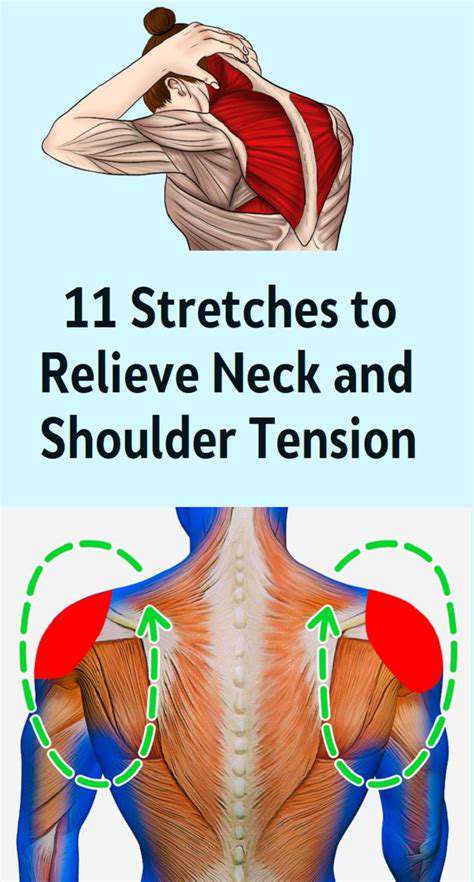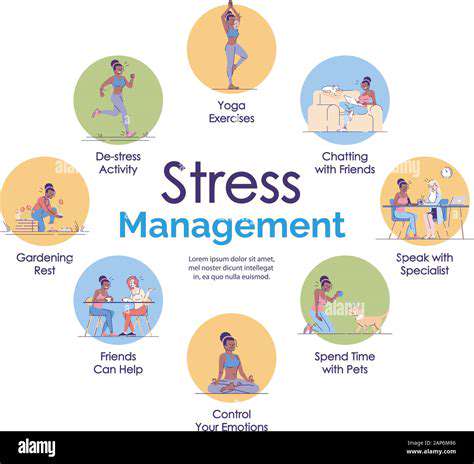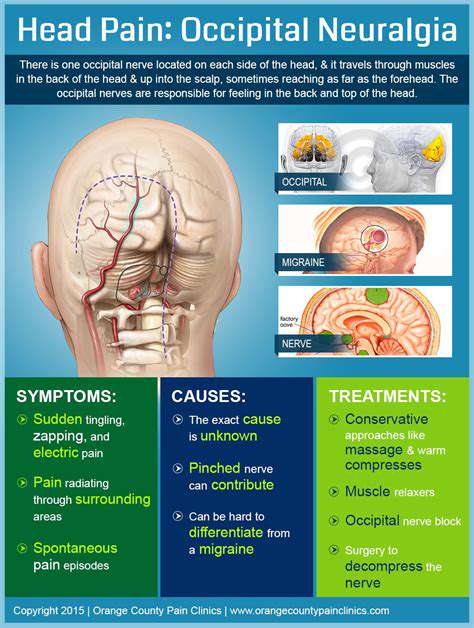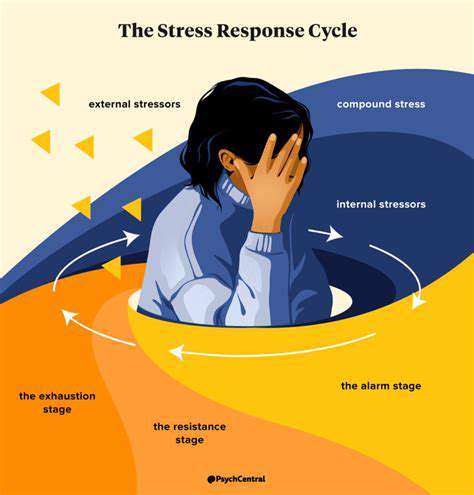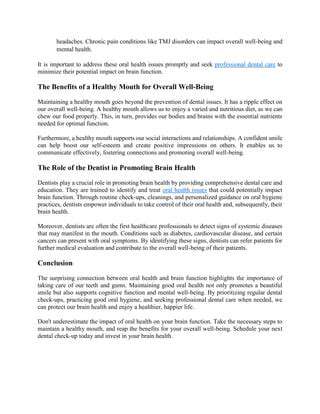Dealing with Migraine Related Anxiety and Depression
The Power of Support Systems and Self-Care
Understanding Migraine-Related Anxiety
Migraine headaches aren't just about throbbing pain; they can often trigger or exacerbate anxiety. This anxiety can manifest in various ways, from feeling overwhelmed and stressed to experiencing panic attacks. Understanding this connection is crucial to developing effective coping mechanisms. Recognizing the cyclical nature of migraine and anxiety—where one can fuel the other—is vital for breaking the vicious cycle and improving overall well-being.
The physical sensations of a migraine, like the throbbing pain, nausea, and sensitivity to light and sound, can create a heightened state of anxiety. This heightened awareness and the anticipation of future attacks can lead to significant emotional distress and impact daily life.
The Role of Support Systems
Having a strong support system is paramount when dealing with migraine-related anxiety. This network of friends, family, or support groups provides emotional validation, practical assistance, and a sense of belonging. Sharing experiences and coping strategies with others who understand the challenges of migraine can significantly reduce feelings of isolation and empower individuals to seek help.
Don't hesitate to lean on your support system during challenging times. Open communication about your struggles with migraine and anxiety is essential for building a supportive environment. Seeking help and support is a sign of strength, not weakness.
Identifying and Addressing Triggers
Identifying migraine triggers is a crucial step in managing both the physical pain and the accompanying anxiety. These triggers can range from stress and lack of sleep to certain foods, environmental factors, or hormonal fluctuations. Keeping a detailed headache diary can help pinpoint patterns and potentially avoid future attacks.
Once identified, these triggers can be addressed proactively. This might involve making lifestyle changes, such as improving sleep hygiene, managing stress levels effectively, or modifying dietary habits to reduce potential migraine-inducing foods.
The Importance of Self-Care Practices
Self-care is not a luxury, but a necessity when navigating migraine-related anxiety. Prioritizing activities that promote relaxation and well-being, such as mindfulness exercises, deep breathing techniques, or engaging in hobbies, can significantly reduce stress and anxiety levels. These practices can help individuals regain a sense of control and calm amid the challenges of migraine.
Regular exercise, a healthy diet, and sufficient sleep are fundamental to overall well-being and can play a significant role in mitigating migraine triggers and reducing anxiety. Consistent self-care routines can help establish a foundation for managing both the physical and emotional aspects of migraine.
Seeking Professional Help
Don't hesitate to seek professional help if migraine-related anxiety becomes overwhelming. A healthcare provider can provide a diagnosis, recommend appropriate treatments, and connect individuals with mental health professionals who specialize in managing chronic pain conditions and anxiety disorders.
Therapists can offer coping mechanisms, strategies for managing stress, and techniques for managing anxiety attacks. They can also help individuals develop healthier ways of thinking about and responding to migraine triggers and the resulting anxiety.
Developing Coping Mechanisms
Developing coping mechanisms specific to migraine-related anxiety is essential. These strategies could include relaxation techniques like progressive muscle relaxation, guided imagery, or meditation. Creating a personalized toolbox of coping mechanisms can equip individuals with the tools to effectively manage anxiety episodes during a migraine attack or in anticipation of one.
Learning to recognize and manage early warning signs of a migraine can also be a powerful coping mechanism. By proactively addressing these early warning signs, individuals can potentially mitigate the severity of the attack and the associated anxiety.
Building Resilience and Acceptance
Building resilience and acceptance is a crucial part of living with migraine-related anxiety. This involves acknowledging the challenges, learning to cope with setbacks, and recognizing that recovery is a journey, not a destination. Resilience is cultivated through consistent self-compassion and a focus on personal growth and well-being.
Acceptance of the condition, while not a cure, can significantly reduce the emotional toll of living with migraine-related anxiety. It's about acknowledging the reality of the condition without letting it define your life or overwhelm you with worry.
Seeking Professional Help and Ongoing Management

Understanding the Need for Professional Support
Seeking professional help for any issue, whether personal or professional, is a courageous and often vital step toward growth and well-being. It signifies a willingness to acknowledge that sometimes, we need external support to navigate challenging situations and develop effective coping mechanisms. Acknowledging this need is a sign of strength, not weakness.
Often, problems can become overwhelming and lead to feelings of isolation and despair. Professional help can provide a safe and supportive space to explore these issues and develop healthier ways of managing them.
Identifying Potential Challenges
A wide range of challenges can benefit from professional guidance. These might include relationship difficulties, stress management issues, mental health concerns, career transitions, or personal development goals. Identifying the specific areas where you're struggling is the first crucial step in seeking the right kind of support.
The Role of a Professional Counselor
Professional counselors are trained to provide guidance and support in a variety of areas. They offer a non-judgmental space for exploring difficult emotions and experiences. Their expertise allows them to help you develop coping strategies and problem-solving skills that can lead to lasting positive change.
Counselors are equipped to help you understand your unique experiences and develop personalized strategies for growth. This tailored approach fosters a deeper level of understanding and actionable solutions.
Navigating the Process of Seeking Help
Finding the right professional can feel daunting. Researching credentials, experience, and specializations is crucial. Consider factors such as your specific needs and preferences when making your choice.
Take your time and don't hesitate to reach out to multiple professionals if needed to find the best fit for you. Open communication and trust are essential elements of a successful therapeutic relationship.
Exploring Different Types of Support
Various types of professional support are available, including therapy, counseling, coaching, and support groups. Each approach offers unique benefits and caters to different needs and preferences. Exploring these options can help you discover the most suitable path for your specific situation.
Building a Support System
Seeking professional help doesn't have to be a solitary journey. Building a strong support system, including friends, family, or support groups, can significantly enhance your well-being and provide additional perspectives and encouragement throughout your process.
The Importance of Consistency and Patience
Making positive changes takes time and effort. Be patient with yourself and the process. Maintaining consistent engagement with your chosen professional is crucial for achieving desired outcomes. Consistency allows for deeper exploration and development of effective strategies.
Consistency and patience are key to unlock your full potential and achieve a more fulfilling and healthy life. It's a journey, not a destination, and progress is often gradual and rewarding.
